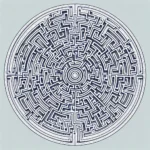The Porteus Maze Test is a well-known psychological assessment tool used to measure an individual’s planning ability, foresight, impulse control, and cognitive functioning. Developed by Australian psychologist Stanley Porteus in the early 20th century, this test has been utilized for decades to help professionals understand various aspects of human behavior and intellectual development.
Understanding the Porteus Maze Test
At its core, the Porteus Maze Test consists of a series of maze puzzles that an individual is required to solve. Unlike standard maze puzzles, these are printed on paper, and the person taking the test uses a pencil to draw a line through the maze from the start to the finish without lifting the pencil or crossing the lines. The mazes vary in complexity, with more complicated mazes designed for older age groups.
This unique approach makes the Porteus Maze Test not just a measure of visual-motor coordination but also an insightful gauge of executive function capabilities. By analyzing how individuals approach the task, it is possible to derive significant insights into their planning and problem-solving skills. This is why the Porteus Maze Test has been a cornerstone in neuropsychological evaluation and continues to be used in various sectors, including clinical, educational, and occupational settings.
Application in Different Settings
In clinical psychology, the Porteus Maze Test may be used to assess patients with attention deficit hyperactivity disorder (ADHD), brain injuries, or neurodegenerative diseases. It helps professionals understand the severity of the impairments such individuals face and aids in formulating personalized intervention strategies.
Educators also find the Porteus Maze Test valuable, especially when dealing with children who exhibit learning difficulties. Through the test, educators can identify specific areas where a child may need additional support and can tailor educational programs to cater to their learning needs.
Moreover, the Porteus Maze Test is sometimes employed in occupational psychology to evaluate candidates for particular jobs that require advanced planning skills and decision-making abilities. Organizations may use the test to ensure that potential employees possess the appropriate level of cognitive capacity for certain roles.
Scoring and Interpretation
Scoring the Porteus Maze Test is nuanced, as it factors in more than just the completion of the mazes. It takes into account the number of errors, such as entering cul-de-sacs or dead ends and the approaches taken by participants to avoid mistakes. Psychologists can deduce valuable information about a person’s ability to learn from mistakes, adapt strategies, and maintain concentration through careful observation and analysis of scores.
For instance, frequently stepping into dead ends without correcting one’s path may indicate impulsive behavior or a lack of strategic foresight. On the other hand, a person who shows the ability to avoid previous errors in subsequent attempts demonstrates adaptability and learning capability.
Interpreting the results of the Porteus Maze Test requires professional expertise. Psychologists consider not only the score but also the individual’s background, such as age, cultural context, and educational level, to provide a comprehensive assessment.
Advantages and Limitations
One of the significant advantages of the Porteus Maze Test is its nonverbal nature, making it broadly applicable across different linguistic and cultural groups. This quality allows it to be used in diverse populations without cultural bias affecting the outcome significantly.
Moreover, the test is straightforward to administer and requires minimal training, allowing it to be conveniently utilized in various environments. Its simplicity is paired with a strong predictive value in gauging intellectual maturity and executive functions.
However, the Porteus Maze Test does have its limitations. Critics argue that performance on the test can be influenced by factors unrelated to cognitive function, such as motor skills or prior experience with mazes. There is also the argument that it might not fully capture the complexity of human planning abilities and impulse control, as these are multifaceted constructs that are difficult to measure with a single instrument.
Despite these limitations, the test’s use, particularly in combination with other assessment tools, provides a holistic view of an individual’s cognitive abilities and can contribute to effective treatment plans or educational approaches. It remains a staple among psychologists for its historical value, ease of use, and practical insight into human cognition.
Conclusion
The Porteus Maze Test represents a fascinating intersection between simplicity and depth in psychological assessment. It showcases how a simple task like navigating a maze can unravel complexities of the human mind. As a psychological tool, it confirms the adage that often, less is more. For researchers, clinicians, educators, and even employers, the Porteus Maze Test continues to be an invaluable resource for unveiling the intricacies of cognitive development and executive functioning.
Given the evolution of psychology and advancements in assessment techniques, it is likely that the Porteus Maze Test will undergo further refinement and perhaps be integrated with technology-enhanced methods to cater to a new generation of participants. The future of cognitive assessment appears promising, with tools like the Porteus Maze Test leading the way in both theoretical understanding and practical application.
As the field of psychology continues to evolve, incorporating insights from neuroscience, artificial intelligence, and machine learning, the classic tests like the Porteus Maze Test will undoubtedly adapt and transform. Yet, their fundamental purpose—to decode the labyrinth of human cognition—will undoubtedly remain the same, guiding us through the intricate mazes of the mind.

